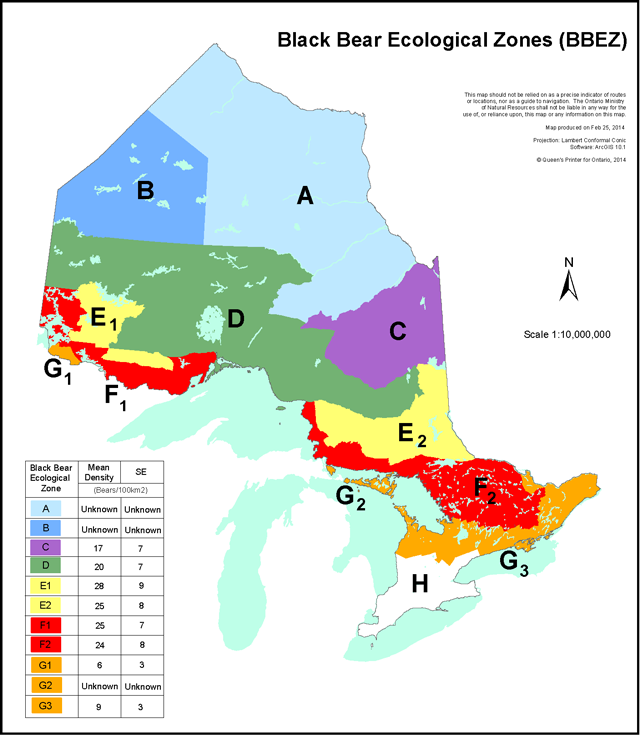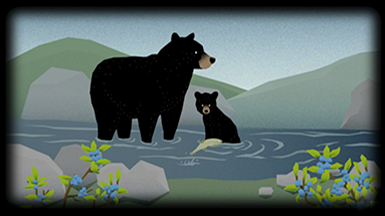Ontario.ca needs JavaScript to function properly and provide you with a fast, stable experience.
To have a better experience, you need to:
Prevent and report encounters with black bears and learn who to contact.
Emergency
Call 911 or your local police
Non-emergency
Call
Not every bear sighting is an emergency situation. Here is who to call if you encounter a bear.
Call 911 or your local police if a bear poses an immediate threat to personal safety and exhibits threatening or aggressive behaviour, such as:
Police will respond first to an emergency situation, but may request assistance from the ministry during daylight hours.
Call the toll-free Bear Wise reporting line at
This line operates 24 hours a day, seven days a week, from April 1 to November 30.
Stop. Do not panic. Remain calm.
Generally, the noisier the bear is, the less dangerous it is, provided you do not approach. The noise is meant to “scare” you off and acts as a warning signal.
Keep your dog on a leash when out in bear country. Be aware that unleashed dogs can cause defensive black bear attacks on people. Unleashed dogs returning to their owners can cause a chase response that may lead a bear back to the owner. Take these precautions with your dog:
Unleashed dogs can surprise bears and cause a defensive attack on dogs and their owners. Always keep your dog on a leash. To avoid attracting bears, do not leave dog food outdoors, in screened-in areas or porches. Mother bears with cubs will normally avoid interacting with humans.
Bears are smart, curious, powerful and potentially dangerous. They do not like surprises. If you are a hiker, cyclist, jogger, berry picker or you plan to spend some time outdoors in bear country, learn to be Bear Wise to avoid an encounter.
A surprised black bear will give off warning signs to let you know you are too close. For example, a black bear standing on its hind legs is not a sign of aggressive behaviour. The bear is trying to get a better look at you or catch your scent. Unleashed dogs can make these situations more dangerous. Always keep your dog on a leash when out in bear country.
Alert bears to your presence so they can avoid you. Make noise such as singing, whistling or talking while you are in areas with restricted visibility or with high background noise, such as near streams, waterfalls or on windy days.
Cubs typically stay with their mother bear for 1.5 years. If you see a cub or small bear, there is a good chance that the mother is nearby. Take caution.
There are two types of warning behaviours that you may experience during a bear encounter.
When bears are surprised, they can become stressed. They usually just want to flee. In some cases, bears may become defensive. Female bears with cubs present tend to be more aggressive in defence of their cubs and should be treated with extra caution.
A bear that feels threatened will:
A bear that is predatory:
If you have tried everything possible to get a bear to leave your property and you are afraid for your safety, you have the right to protect yourself and your property.
Killing a bear in self-defence must be an action of last resort.
Any action you take must be done:
You do not need a hunting licence to kill a bear in self-defence, however:
Learn how to be Bear Wise while outdoors, at your home, cottage, school, business or farm.
Enlarge bear density map
Black bears live throughout most of Ontario. They primarily inhabit forested areas where they are best able to find food, refuge and den sites.
Black bears are born in their dens in January and remain in hibernation with their mother until spring (around April). At this time, cubs are usually up to 10 pounds, about the size of a house cat.
Cubs will quickly put on weight. They can grow up to 60 pounds by the time they go into hibernation their first full winter. Despite how quickly they grow, cubs will stay with their mothers for a second winter and will only venture off on their own the following summer when they are 17-18 months old for mating season (around June).
When fully grown:
Black bear sizes will vary greatly year over year and depend on the availability of natural foods.
Bears’ entire life revolves around food. When they are not hibernating, bears spend most of their time looking for food.
Be Bear Wise – Hibernation (Video)
From the time they come out of hibernation until berry crops are available, bears live off their stored fat and the limited energy provided by fresh spring greens. Although they are formally classified as carnivores, meaning they mostly eat meat, their diet is truly omnivorous, meaning they eat both plants and animals. They get most of their food energy by feeding on summer berry crops like blueberries, raspberries, and cherries. In the fall, they turn their attention to hazel nuts, mountain ash, acorns and beech nuts.
Though black bears will eat carrion, insects, fish, deer fawns and moose calves, the bulk of their diet is plant material. Their natural preference is to find lots of high energy food, like berry patches, that will help them fatten up fast. Their survival and ability to have and raise young depend on their ability to put on weight before going into winter hibernation. The availability of their natural food varies from season to season and from year to year and will affect their reproduction rate.
When there is a lot of natural foods available, the number of reported bear sightings are lower. When natural food sources are scarce, reported sightings are higher because black bears will look for alternative food sources, sometimes in urban or developed areas.
Be Bear Wise – Risk and Reward (Video)
Bears need 20,000 calories a day to prepare for hibernation— that’s 78 pounds of blueberries, 672 acorns, nearly 25,000 tent caterpillars or one seven-pound birdfeeder filled with black oil sunflower seed.
It takes the local community to prevent conflicts with bears. You may be doing your part, but if your neighbour is not, you may still encounter a bear on your property as a result.
Commit your community to becoming Bear Wise. Remind your neighbours to do their part by:
Protecting Ontario’s biodiversity while promoting economic opportunities in the resource sector and supporting outdoor recreation opportunities.
There are many ways to contact the Government of Ontario.
